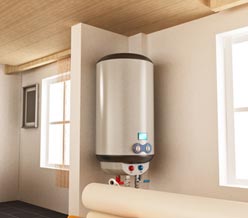Pros and Cons of Tankless Water Heater Installation
Shortly after “indoor plumbing” became practical, we also found ways to heat the water—indeed, this was good news for all. Today, hot water tanks are the most common hot water production and storage types, usually heated by electricity or natural gas.
Approximately 40 or 50 gallons of water are heated and kept hot until needed. As hot water is used, it is replaced by unheated water, and the process starts all over again.
A current option is gradually being introduced around the country—tankless water heaters. They are not for every application, but here is some basic information and pros/cons concerning residential use.
How Tankless Water Heaters Work
There are two types of tankless water heaters.
- Under-the-sink applications require several units to be installed everywhere hot water is needed—bathrooms, kitchens, and laundry rooms. The water is heated immediately at the location and a constant supply of hot water is available.
- Whole-house tankless water heaters use the same principle—heating water upon demand—but the water is delivered throughout the house from a single location. There are a few seconds of delay before hot water is delivered, but the delay is slight.
- Under-the-sink applications should be a part of the new construction or major remodels since they require the right-sized vanities, water, and fuel sources for each location. Whole-house tankless systems can replace tanked systems without demolition or remodeling.
- The most common fuel sources for tankless systems are electricity and natural gas, just like tanked systems.
Pros of Tankless Water Heater Installation
- Tankless systems do not use energy to keep 40 or 50 gallons of water hot to ensure hot water is available upon demand, so they are more efficient than tanked systems. How much is the cost savings with tankless systems? According to the US Department of Energy, they can save $100 per year over tanked systems.
- Tankless systems have a useful life that surpasses tanked systems. Tanked systems generally last between 11 and 15 years, while tankless systems last between 15 and 20 years.
- Whether the application is an under-the-sink or whole-house system, having hot water instantly is very convenient and comfortable. With under-the-sink systems, this supply is veritably endless.
Cons of Tankless Water Heater Installation
- Tankless systems are more expensive than tanked systems. Tankless systems are approximately twice as expensive as tanked systems; so, if the tanked system for your home might cost $1000, a tankless system will usually cost $2000. However, the annual cost savings will generally repay a homeowner for the cost difference and sometimes more, so there is very little difference in the cost of hot water in the long run.
- Just like tanked systems, if a family has three teens trying to take long showers at the same time, a whole-house system will not keep up with the demand.
Tankless water heater systems require expert installation and maintenance. Certain considerations need to be discussed with an experienced plumber, including mineral content in the water supply and existing water softeners.
The Tankless Water Heater Installation Experts
Let Doctor Cool assist with your Tankless Water Heater Installation needs. Call Doctor Cool & Professor Heat today at 281-338-8751 or email Doctor Cool and let our professional League City Plumbing Repair Contractors assist with your Tankless Water Heater Installation.

